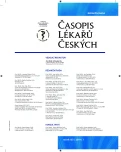Electromagnetic field intolerance: a nonexistent disease?
Authors:
Šárka Šafářová
Authors‘ workplace:
Ústav lékařské etiky, Lékařská fakulta Masarykovy univerzity, Brno
Published in:
Čas. Lék. čes. 2014; 153: 4-6
Category:
Review Article
Overview
Idiopathic Environmental Intolerance Attributed to Electromagnetic Fields is a relatively new phenomenon, which is not fully understood. Extensive research has been carried out to exclude or confirm out that symptoms reported by sufferers are caused by electromagnetic field. This article describes outcomes of recent experiments and meta-analyses. The article may answer to the question if electromagnetic field does really cause reported symptoms, furthermore, it provides hypothetical explanation of this phenomenon.
Keywords:
electromagnetic hypersensitivity – electromagnetic field – nonspecific symptoms – nocebo effect
Sources
1. Genuis SJ, Lipp CT. Electromagnetic hypersensitivity: Fact or fiction? Science of the Total Environment 2012; 1: 103–112.
2. Pekárek L. Hygiena práce - Informace NRL č. 14/2005, [online]. Hygienickástanice hlavního města Prahy. http://www.hygpraha.cz/odbory.php?ksum=MzA
3. Rubin GJ, Munshi JD, Wessely S. Electromagnetic Hypersensitivity:A systematic review of provocation studies. Psychosomatic Medicine 2005; 67: 224–232.
4. Rubin GJ, Nieto-Hernandes R, Wessely S. Idiopathic environmental intolerance attributedto electromagnetic fields (formerly‘electromagnetic hypersensitivity’): an updated systematic review of provocation studies. Bioelectromagnetics 2010; 31: 1–11.
5. Röösli M. Radiofrequency electromagnetic field exposure and non-specificsymptoms of ill health: a systematic review. Environmental Research 2008; 107: 277–287.
6. Tuengler A, von Klitzing L. Hypothesis on how to measure electromagnetic hypersensitivity. Electromagnetic Biology and Medicine 2012; 1–10.
7. Baliatsas C, et al. Idiopathic environmental intolerance attributed to electromagnetic fields (IEI-EMF): A systematic review of identifying criteria. BMC Public Health 2012; 12: 643.
8. Coolman AM. Oxford dictionary of psychology 3rd ed. Oxford: University Press 2009.
9. Dahmen N, Ghezel-Ahmadi D, Engel A. Blood laboratory findings in patients suffering from self-perceived electromagnetic hypersensitivity (EHS). Bioelectromagnetics 2009; 30: 299–306.
10. Rubin GJ, Cleare AJ, Wessely S. Psychological factors associated with self-reported sensitivity to mobile phones. Journal of Psychosomatic Research 2008, 64: 1–9.
11. Eltiti S, et al. Development and Evaluation of the Electromagnetic Hypersensitivity Questionnaire. Bioelectromagnetics 2007; 28: 137–151.
12. Berglund F. Är elallergin verkligen en fobi? Läkartidningen 2001; 14: 1719.
Labels
Addictology Allergology and clinical immunology Angiology Audiology Clinical biochemistry Dermatology & STDs Paediatric gastroenterology Paediatric surgery Paediatric cardiology Paediatric neurology Paediatric ENT Paediatric psychiatry Paediatric rheumatology Diabetology Pharmacy Vascular surgery Pain management Dental HygienistArticle was published in
Journal of Czech Physicians

- Metamizole vs. Tramadol in Postoperative Analgesia
- Metamizole at a Glance and in Practice – Effective Non-Opioid Analgesic for All Ages
- Advances in the Treatment of Myasthenia Gravis on the Horizon
- What Effect Can Be Expected from Limosilactobacillus reuteri in Mucositis and Peri-Implantitis?
- The Importance of Hydration in Wound Healing
Most read in this issue
- Historical aspects of the Smith-Lemli-Opitz syndrome
- Electromagnetic field intolerance: a nonexistent disease?
- Currently available skin substitutes
- Perforation of the small intestine in a non reducible spigelian hernia, by a foreign body
